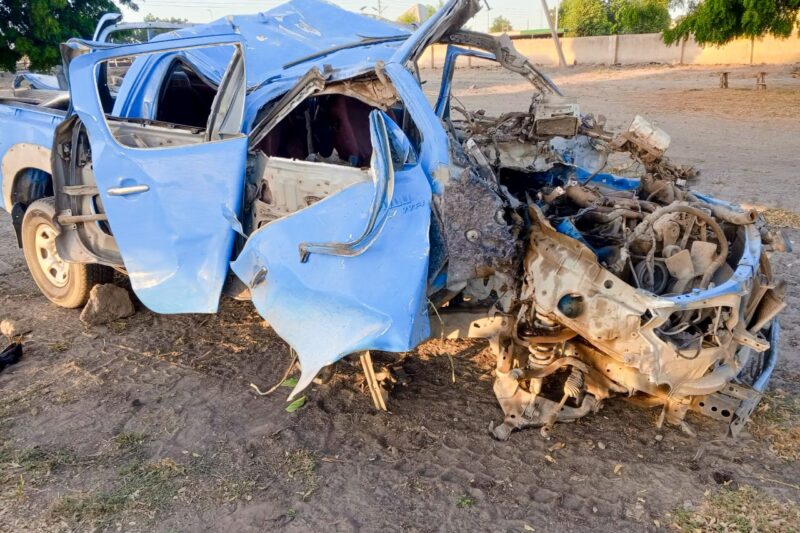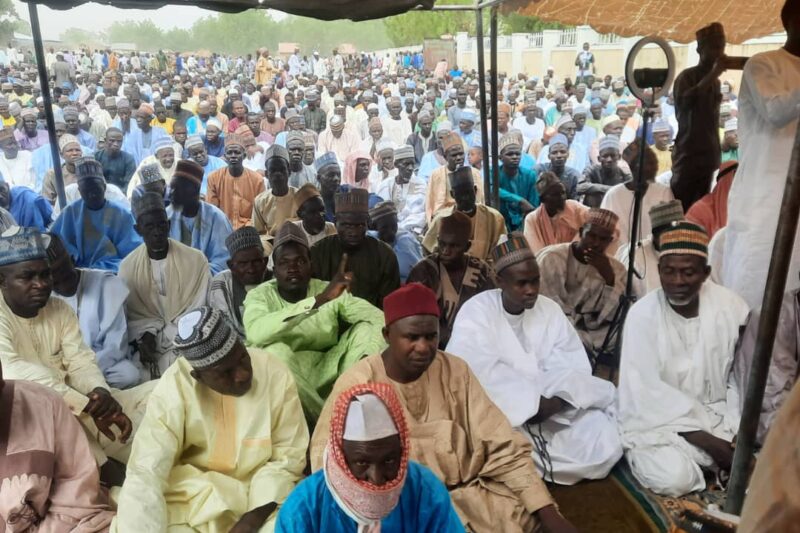At the height of the insurgency in northeast Nigeria, from 2012 to 2014, so many people were killed that the cemeteries reached their capacity and grave diggers were forced to dig large trenches on fields for mass burials.
Since 2009, the Jamā’at Ahl as-Sunnah lid-Da’way Wa’l-Jihād (JAS), better known as Boko Haram, has been one of the largest militant groups in Africa and has targeted religious and political groups, local police, the military, as well as indiscriminately attacking innocent civilians in busy markets and villages.
The United Nations Development Programme (UNDP) said more than 350,000 people had died by the end of 2020. This was 10 times greater than its earlier estimate of 35,000 in 2019.
RNI’s head of news, Mamman Mahmood, spoke to two men whose job it was to bury the dead. They said it was a gruesome job which only got worse when they had to dig mass graves.
They asked to remain anonymous for security reasons, so we shall call them Number 1 and Number 2.
Number 1 said: “During that time, I was working at the Borno State Environmental Protection Agency (BOSEPA) as a humanitarian worker. We were asked to help bury the corpses because the cemetery did not have enough people to do the work. In a single day, as many as 300 bodies and sometimes more were brought from the General Specialists’ Hospital and we buried each corpse in a separate grave. Sometimes we could not even count the number of people we had buried.”
Number 2 said: “I was asked to volunteer to bury the corpses because there were so many dead bodies that the workers at the grave sites were overwhelmed. We went daily to the General Specialists’ Hospital to collect the corpses. In one day we sometimes buried between 300 and 500. In one month I counted 13,600 corpses that we buried in the Gwange Cemetery.
“But there came a time when there was no longer any space left in the cemeteries. We asked the government and they said we could dig big trenches behind the Maimalari Barracks and bury the bodies in mass graves.
“Sometimes the corpses were already decomposing by the time they got to us and you could not recognise the person. The mortuaries were full so the dead bodies were put in an open field. We picked them up from there, buried them and went back for more. The smell was terrible – some of the corpses were covered in maggots. It was not a good sight and it stays with you.
“There were about 200 grave diggers, including those who picked up the corpses. We tried to bury everyone separately but sometimes it just was not possible.
“One day while we were working, four armed Boko Haram members came to us in the Gwange Cemetery. They had guns and told us they had heard we were conducting mass burials. Fortunately, at that time we were still doing single burials. They told us if they had found mass burial sites, they would have gunned us down. Instead, they commended us for doing a courageous job and left.
“The second time two other members of Boko Haram came and threatened us. When we did not respond they left. It was like that until the government provided guards to watch over us.”
Number 1 said that especially when the cemeteries were full they had still tried to bury every corpse separately but sometimes they were forced to conduct mass burials because the cemeteries were full and also because of the condition of the bodies.
“In one incident, 41 police officers were burnt by Boko Haram in an attack on Bama, a local government area in Borno State. They were taken to the teaching hospital in Maiduguri. We had already packed up for the day but we went back to work. The sight of the burnt bodies was hideous. We put all the remains in a polythene bag and buried them in one grave.
“Soldiers used to come from different parts of the state in ambulances to drop off the corpses at the General Specialists’ Hospital. Most of the corpses were youths. I came across only two women, not counting the suicide bombers.
“When the mortuary was full, the corpses were left in an open field. We picked up a group of corpses and then went back for another group. Sometimes, when we were so busy we were not able to pick up the bodies and some of them lay dead on the field for a week. That was when many decomposed. The skin of some corpses was peeling off. Not even their relatives could recognise them. Some of the corpses were skeletons. When they were like that we put them in a sack and buried them in the same place too.’’
Both Number 1 and Number 2 described their jobs at that time as gruesome. They said it was difficult to get over the stench of the bodies, some of whom had been decapitated and others whose bodies were chopped up and their intestines gouged out.
Number 1 said: “The job we did was traumatising. We saw so much horror and it affected us mentally. We did it as part of our humanitarian work. Each day we were given an allowance, soap and a meal.”
He said that at the time they often slept at the BOSEPA office because they were scared Boko Haram might attack them in their homes. He said this was particularly the case when members of the Civilian Joint Task Force (CJTF) found out that a couple of the grave diggers were members of Boko Haram. Once discovered, the CJTF killed them and they were buried.
Number 1 said: “People told us we should stop this kind of work, especially as many grave diggers developed mental problems. But we carried on because we regarded what we did as humanitarian work.”
He said the grave diggers did not take any medicine even though the smell of the corpses and the sight of them had caused health problems.
“Two of our senior staff members died because they did not use face masks. They claimed that they had adapted to the intenseness of the odour. So they continued to work and inhale the polluted air. Eventually, their bodies swelled up and they went to hospital. The doctors said there was nothing they could do and they died.”
Numbers 1 said: “We were never told where the bodies had come from but we suspected some were from the military detention centres. Most were victims of the insurgency. During bomb attacks by insurgents there were so many casualties. Together we must have buried hundreds and hundreds of bodies, including suicide bombers. Those were terrible because we normally found only their heads and pieces of their bodies.”
Number 2 said: “We could easily identify the suicide bombers because they were mostly females and had the same nylon-threaded hairstyles.”
Residents who lived close to the General Specialists’ Hospital told RNI that at the height of the insurgency staying in the area was a nightmare.
Muhammad Mustapha, a resident of Hausari suburb behind the General Specialists’ Hospital, said: “Many killings were recorded and there were many dead and rotting corpses, which smelled so bad that they forced many residents to relocate. I can remember a time when one person died and many others fell sick because of the persistent odour. Sometimes civilians and relatives, who went to see their loved ones in hospital, found out they had died and the military forced them to carry the dead bodies to trucks. This terrified some young people, who just could not bear the smell and sight of death and ran away.”
Ali Mustapha said: “We use to pinch our noses to try to stop the smell. Complaints were made to the hospital committee and then they had the bodies buried and the odour was reduced.
Both Number 1 and Number 2 said the situation had improved since members of the CJTF were brought in because they were able to identify the insurgents and protect the community.
Aisha Jamal








